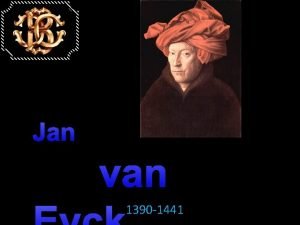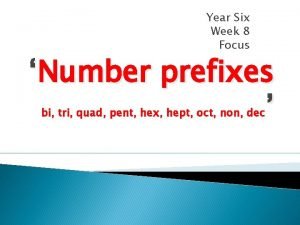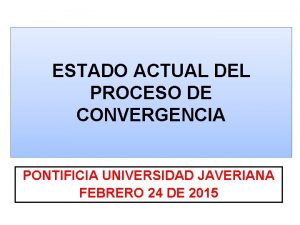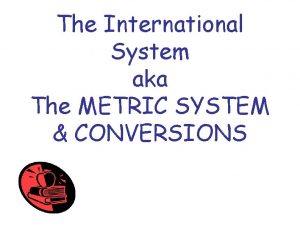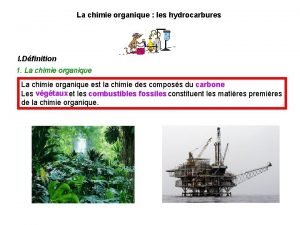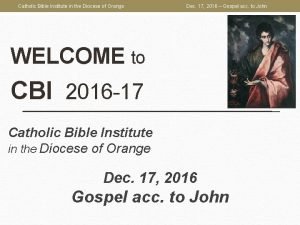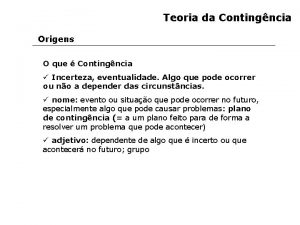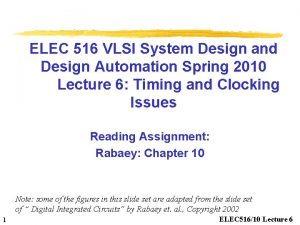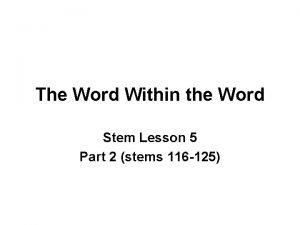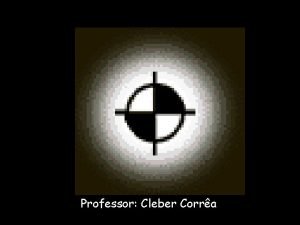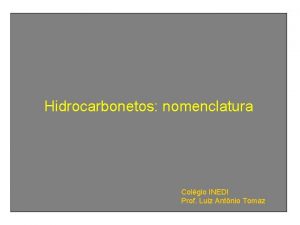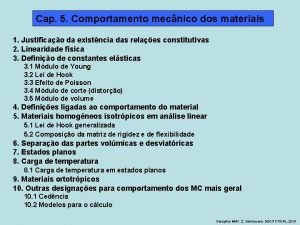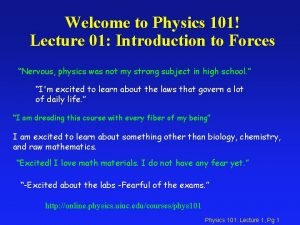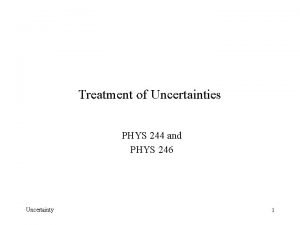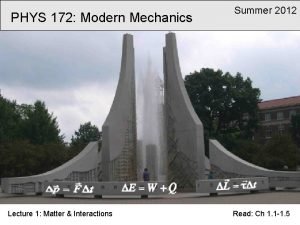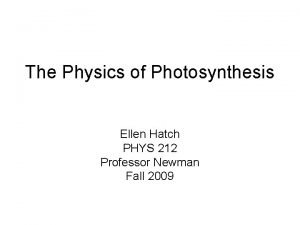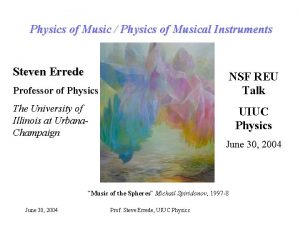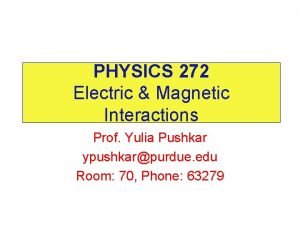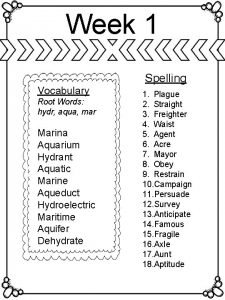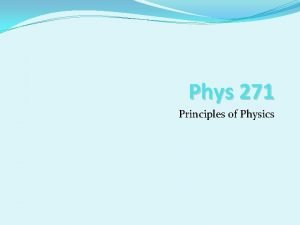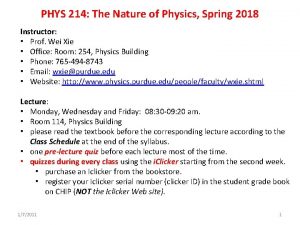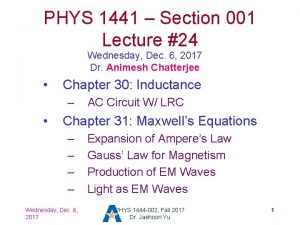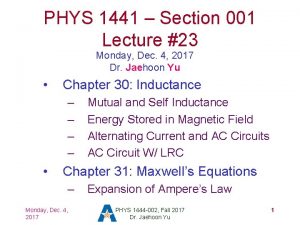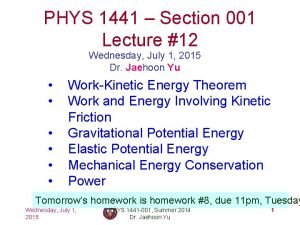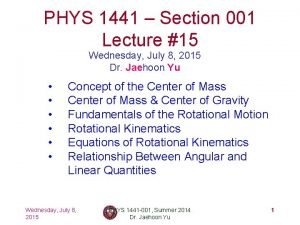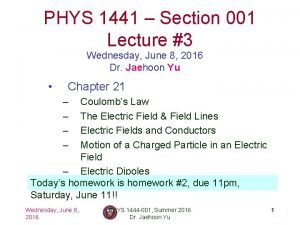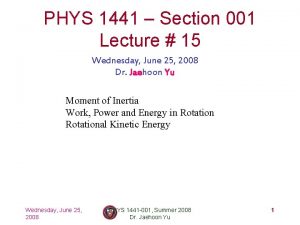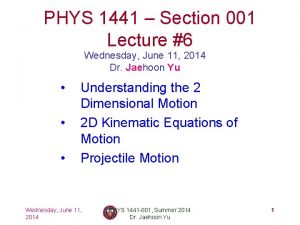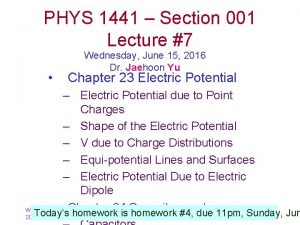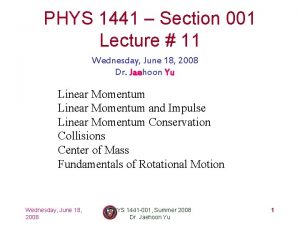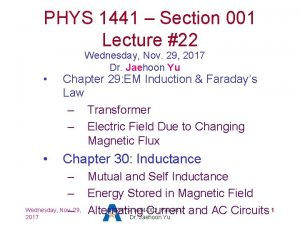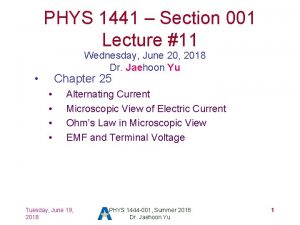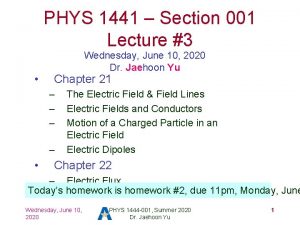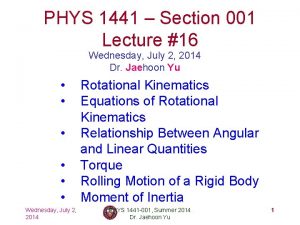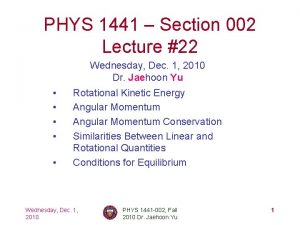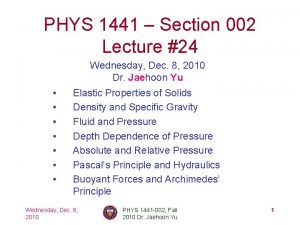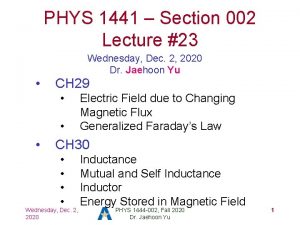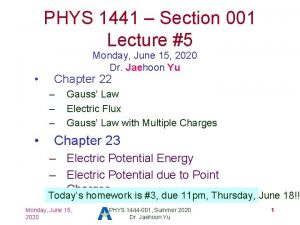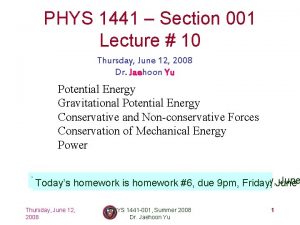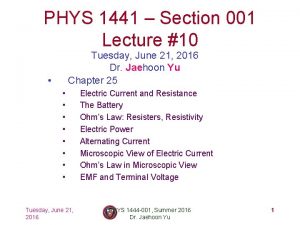PHYS 1441 Section 001 Lecture 24 Wednesday Dec








































- Slides: 40

PHYS 1441 – Section 001 Lecture #24 Wednesday, Dec. 6, 2017 Dr. Animesh Chatterjee • Chapter 30: Inductance – • AC Circuit W/ LRC Chapter 31: Maxwell’s Equations – – Monday, Dec. 4, 2017 Expansion of Ampere’s Law Gauss’ Law for Magnetism Production of EM Waves Light as EM Waves PHYS 1444 -002, Fall 2017 Dr. Jaehoon Yu 1

Announcements • Reading Assignments – CH 30. 10 and CH 30. 11 • Final exam – Date and time: 11 am – 12: 30 pm, Monday, Dec. 11 in SH 101 – Comprehensive exam: covers CH 21. 1 through what we finish today. Wednesday, Dec. 6 – Bring your calculator but DO NOT input formula into it! • Cell phones or any types of computers cannot replace a calculator! – BYOF: You may bring a one 8. 5 x 11. 5 sheet (front and back) of handwritten formulae and values of constants Wednesday, Nov. 29, PHYS 1444 -002, Fall 2017 or solutions of any 2 – No derivations, word definitions 2017 Dr. Jaehoon Yu

AC Circuit w/ LRC • Since the sum of the projections of the three vectors on the y axis is equal to the projection of their sum. • – The sum of the projections represents the instantaneous voltage across the whole circuit which is the source voltage – So we canan useangle the sumφofto all V vectors as the V forms and 0 representation of the peak source R 0 voltagerotates V 0. together with the other vectors as a function of time, • We determine the total impedance Z of the circuit defined by the relationship or • From Pythagorean theorem, we obtain • Thus the total impedance is Monday, Dec. 4, 2017 PHYS 1444 -002, Fall 2017 Dr. Jaehoon Yu 3

AC Circuit w/ LRC • The phase angle φ is • or • What is the power dissipated in the circuit? – Which element dissipates the power? – Only the resistor • The average power is – Since R=Zcosφ – We obtain – The factor cosφ is referred as the power factor of the circuit – For a pure resistor, cosφ=1 and – For a capacitor or inductor alone φ=-90 o or +90 o, so cosφ=0 and Monday, Dec. 4, 2017 PHYS 1444 -002, Fall 2017 Dr. Jaehoon Yu 4

Maxwell’s Equations • The development of EM theory by Oersted, Ampere and others was not done in terms of EM fields – The idea of fields was introduced somewhat by Faraday • Scottish physicist James C. Maxwell unified all the phenomena of electricity and magnetism in one theory with only four equations (Maxwell’s Equations) using the concept of fields – This theory provided the prediction of EM waves – As important as Newton’s law since it provides dynamics of electromagnetism – This theory is also in agreement with Einstein’s special relativity • The biggest achievement of 19 th century electromagnetic theory is the prediction and experimental verifications that the electromagnetic waves can travel through the empty space – What do you think this accomplishment did? • Open a new world of communication • It also yielded the prediction that the light is an EM wave • Monday, Since. Dec. all 4, of Electromagnetism is contained in the four PHYS 1444 -002, Fall 2017 Dr. Jaehoon Yu Maxwell’s equations, this is considered as one of the 5

Ampere’s Law • Do you remember the mathematical expression of Oersted discovery of a magnetic field produced by an electric current, given by Ampere? • We’ve learned that a varying magnetic field produces an electric field • Then can the reverse phenomena, that a changing electric field producing a magnetic field, possible? PHYS 1444 -002, Fall 2017 – If this is the case, it. Dr. would demonstrate a Jaehoon Yu Monday, Dec. 4, 2017 6

• Expanding Ampere’s Let’s consider a Law wire carrying current I – The current that is enclosed in the loop passes through the surface # 1 in the figure – We could imagine a different surface # 2 that shares the same enclosed path but cuts through the wire in a different location. What is the current that passes through the surface? • Still I. – So the Ampere’s law still works • We could then consider a capacitor being charged up or being discharged. – The current I enclosed in the loop passes through the surface #1 – However the surface #2 that shares the same closed loop do not have any current passing through it. • There is magnetic field present since there is current In other words there is a changing electric field in between the plates Monday, Dec. 4, PHYS 7 • Maxwell resolved this by 1444 -002, adding. Fall an 2017 additional term to Ampere’s 2017 Dr. Jaehoon Yu law involving the changing electric field

Modifying Ampere’s Law • To determine what the extra term should be, we first have to figure out what the electric field between the two plates is – The charge Q on the capacitor with capacitance C is Q=CV • Where V is the potential difference between the plates – Since V=Ed • Where E is the uniform field between the plates, and d is the separation of the plates – And for parallel plate capacitor C=ε 0 A/d – We obtain Monday, Dec. 4, 2017 PHYS 1444 -002, Fall 2017 Dr. Jaehoon Yu 8

Modifying Ampere’s Law – If the charge on the plate changes with time, we can write – Using the relationship between the current and charge we obtain • Where ΦE=EA is the electric flux through the surface between the plates Extra – So in order to make Ampere’s law work for term the by Maxwell surface 2 in the figure, we must write it in the following form PHYS 1444 -002, the Fall 2017 – This equation represents general form of Dr. Jaehoon Yu Monday, Dec. 4, 2017 9

Example 31 – 1 Charging capacitor. A 30 -p. F air-gap capacitor has circular plates of area A=100 cm 2. It is charged by a 70 -V battery through a 2. 0 -Ω resistor. At the instance the battery is connected, the electric field between the plates is changing most rapidly. At this instance, calculate (a) the current into the plates, and (b) the rate of change of electric field between the plates. (c) Determine the magnetic field induced between the plates. Assume E is uniform between the plates at any instant and is zero at all points beyond the RC edges of the plates. Since this is an circuit, the charge on the plates For theis: initial current (t=0), we differentiate the charge with respect to time. The electric field is Change of the electric field is Monday, Dec. 4, 2017 PHYS 1444 -002, Fall 2017 Dr. Jaehoon Yu 10

Example 31 – 1 (c) Determine the magnetic field induced between the plates. Assume E is uniform between the plates at any instant and is zero at all points beyond the edges the plates. The magnetic fieldoflines generated by changing electric field is perpendicular to E and is circular due to symmetry Whose law can we use to Extended Law w/ determine Ampere’s B? IWe encl=0! choose a circular path of radius r, centered at the center of the plane, following the B. since E is uniform throughout the For r<rplate, the electric plate flux is So from Ampere’s law, we obtain For Solving for B r<rplate Since we assume E=0 for r>rplate, the electric flux beyond the plate is fully contained inside the surface. So from Ampere’s law, we obtain Solving for B For Monday, Dec. 4, PHYS 1444 -002, r>r Fall 2017 11 plate 2017 Dr. Jaehoon Yu

Displacement Current • Maxwell interpreted the second term in the generalized Ampere’s law equivalent to an electric current – He called this term as the displacement current, ID – While the other term is called as the conduction current, I • Ampere’s law then can be written as – Where – While it is in effect equivalent to an electric current, a flow of electric charge, PHYS this 1444 -002, actually not have anything Monday, Dec. 4, Fall does 2017 12 to 2017 do with the flow itself Dr. Jaehoon Yu

Gauss’ Law for Magnetism • If there is a symmetry between electricity and magnetism, there must be an equivalent law in magnetism as the Gauss’ Law in electricity • For a magnetic field B, the magnetic flux ΦB through the surface is defined as – Where the integration is over the area of either an open or a closed surface • The magnetic flux through a closed surface which completely encloses a volume is Gauss’ for total net charge – The electric flux through a closed surface is equal. Law to the electricity Q enclosed by the surface divided by ε 0. • What was the Gauss’ law in the electric case? • Similarly, we can write Gauss’ law for Gauss’ Law foras magnetism 4, PHYS 1444 -002, • Monday, Why. Dec. is result of the integral zero? Fall 2017 Dr. Jaehoon Yu 13 – There is no isolated magnetic poles, the magnetic equivalent of single

Gauss’ Law for Magnetism • What does the Gauss’ law in magnetism mean physically? – There as many magnetic flux lines that enter the enclosed volume as leave it – If magnetic monopole does not exist, there is no starting or stopping point of the flux lines • Electricity do have the source and the sink – Magnetic field lines must be continuous – Even for bar magnets, the field lines exist both insides and outside of the magnet Monday, Dec. 4, 2017 PHYS 1444 -002, Fall 2017 Dr. Jaehoon Yu 14

Maxwell’s Equations • In the absence of dielectric or magnetic materials, the four equations developed by Gauss’ Law for Maxwell are: Aelectricity generalized form of Coulomb’s law relating electric field to its sources, the electric charge Gauss’ Law for magnetism A magnetic equivalent of Coulomb’s law relating magnetic field to its sources. This says there are no magnetic monopoles. Faraday’s Lawby a changing An electric field is produced magnetic field Ampére’s Law field is produced A magnetic Monday, Dec. 4, 2017 PHYS 1444 -002, Fall 2017 Dr. Jaehoon Yu by an electric current or by a changing electric field 15

Maxwell’s Amazing Leap of Faith • According to Maxwell, a magnetic field will be produced even in an empty space if there is a changing electric field – He then took this concept one step further and concluded that • If a changing magnetic field produces an electric field, the electric field is also changing in time. • This changing electric field in turn produces the magnetic field that also changes. • This changing magnetic field then in turn produces the electric field that changes. • This process continues. – With the manipulation of the equations, Maxwell found that the net result of this interacting changing fields is a wave fields that can actually 16 Monday, Dec. 4, of electric and PHYSmagnetic 1444 -002, Fall 2017 Dr. Jaehoon Yu propagate (travel) through the space

Production of EM Waves • Consider two conducting rods that will serve as an antenna are connected to a DC power source – What do you think will happen when the switch is closed? • The rod connected to the positive terminal is charged positive and the other negatively • Then the electric field will be generated between the two rods • Since there is current that flows through, the rods generates a magnetic field around them • How far would the electric and magnetic fields extend? – In static case, the field extends indefinitely – When the switch is closed, the fields are formed nearby the rods quickly but Monday, Dec. 4, PHYS 1444 -002, Fall 2017 – The stored energy in. Dr. the fields 2017 Jaehoon Yu won’t propagate w/ 17

Production of EM Waves • What happens if the antenna is connected to an ac power source? – When the connection was initially made, the rods are charging up quickly w/ the current flowing in one direction as shown in the figure • The field lines form as in the dc case • The field lines propagate away from the antenna – Then the direction of the voltage reverses • The new field lines with the opposite direction forms • While the original field lines still propagates away from the rod reaching out far – Since the original field propagates through an empty space, the field lines must form a closed loop (no charge exist) • Since changing electric and magnetic fields produce changing magnetic and electric fields, the fields moving outward is self supporting and do not need antenna with flowing charge – The fields far from the antenna is called the radiation field Monday, Dec. 4, PHYS 1444 -002, Fall 2017 Dr. fields Jaehoonform Yu closed loops – Both electric and magnetic 18

Properties of Radiation Fields • The fields travel on the other side of the antenna as well • The field strength are the greatest in the direction perpendicular to the oscillating charge while along the direction is 0 • The magnitude of E and B in the radiation field decrease with distance as 1/r • The energy carried by the EM wave is proportional to the square of the amplitude, E 2 or B 2 2 – So the intensity of wave decreases as 1/r Monday, Dec. 4, PHYS 1444 -002, Fall 2017 Dr. Jaehoon Yu 19

Properties of Radiation Fields • The electric and magnetic fields at any point are perpendicular to each other and to the direction of motion • The fields alternate in direction – The field strengths vary from maximum in one direction, to 0 and to max in the opposite direction • The electric and magnetic fields are in phase • Very far from the antenna, the field lines are pretty flat over a reasonably large area Monday, Dec. 4, PHYS 1444 -002, Fall 2017 20 Dr. Jaehoon Yu – Called plane waves 2017

EM Waves • If the voltage of the source varies sinusoidally, the field strengths of the radiation field vary sinusoidally • We call these waves EM waves • They are transverse waves • EM waves are always waves of fields – Since these are fields, they can propagate through an empty space • In general accelerating electric charges give rise to electromagnetic waves • This prediction from Maxwell’s equations was Monday, Dec. 4, PHYS 1444 -002, Fall 2017 21 experimentally by Heinrich Hertz through the 2017 Dr. Jaehoon Yu

EM Waves and Their Speeds • Let’s consider a region of free space. What’s a free space? – An area of space where there is no charges or conduction currents – In other words, far from emf sources so that the wave fronts are essentially flat or not distorted over a reasonable area – What are these flat waves called? • Plane waves • At any instance E and B are uniform over a large plane perpendicular to the direction of propagation – So we can also assume that the wave is traveling in the x-direction w/ velocity, v=vi, and that E is parallel and B is. Fallparallel to z axis 22 Monday, Dec. 4, to y axis PHYS 1444 -002, 2017 Dr. Jaehoon Yu

Maxwell’s Equations w/ Q=I=0 • In this region of free space, Q=0 and I=0, thus the four Maxwell’s equations become Qencl=0 No Changes Iencl=0 One can observe the symmetry between electricity and magnetism. The last equation is the most important one for EM waves and their propagation!! Monday, Dec. 4, PHYS 1444 -002, Fall 2017 23 2017 Dr. Jaehoon Yu

EM Waves from Maxwell’s Equations • If the wave is sinusoidal w/ wavelength l and frequency f, such traveling wave can be written as – Where Thus – What is v? • It is the speed of the traveling wave – What are E 0 and B 0? • The amplitudes. PHYS of the EM wave. Maximum values 24 of 1444 -002, Fall 2017 Dr. Jaehoon Yu E and B field strengths. Monday, Dec. 4, 2017

From Faraday’s Law • Let’s apply Faraday’s law – to the rectangular loop of height Δy and width dx • along the top and bottom of the loop is 0. Why? – Since E is perpendicular to dl. – So the result of the integral through the loop counterclockwise becomes – For the right-hand side of Faraday’s law, the magnetic flux through the. Thus loop changes as – Monday, Dec. 4, 2017 Since E and B depend on x and t PHYS 1444 -002, Fall 2017 Dr. Jaehoon Yu 25

From Modified Ampére’s Law • Let’s apply Maxwell’s 4 th equation – to the rectangular loop of length Δz and width dx • along the x-axis of the loop is 0 – Since B is perpendicular to dl. – So the result of the integral through the loop counterclockwise becomes – For the right-hand side of the equation is Thus – Monday, Dec. 4, 2017 Since E and B depend on x and t PHYS 1444 -002, Fall 2017 Dr. Jaehoon Yu 26

Relationship between E, B and v • Let’s now use the relationship from Faraday’s law • Taking the derivatives of E and B as given their traveling wave form, we obtain We obtain Sinc e Thus – Since E and B are in phase, we can write • This is valid at any point and time in space. What is Monday, v? Dec. 4, PHYS 1444 -002, Fall 2017 27 2017 Dr. Jaehoon Yu

Speed of EM Waves • Let’s now use the relationship from Apmere’s law • Taking the derivatives of E and B as given their traveling wave form, we obtain Sinc e We obtain Thus – However, from the previous page we obtain – Thus Monday, Dec. 4, The speed 2017 PHYS 1444 -002, Fall 2017 28 of EM waves is the Dr. same Jaehoonas Yuthe speed of light. EM waves

Speed of Light w/o Sinusoidal Wave Forms • Taking the time derivative on the relationship from Ampere’s laws, we obtain • By the same token, we take position derivative on the relationship from Faraday’s law • From these, we obtain an d • Since the equation for traveling wave is • By correspondence, we obtain • A natural outcome of Maxwell’s equations is that E and B obey the wave equation for waves traveling w/ speed – Maxwell predicted the existence of EM waves based on PHYS 1444 -002, Fall 2017 29 this Dr. Jaehoon Yu Monday, Dec. 4, 2017

Light as EM Wave • People knew some 60 years before Maxwell that light behaves like a wave, but … – They did not know what kind of waves they are. • Most importantly what is it that oscillates in light? • Heinrich Hertz first generated and detected EM waves experimentally in 1887 using a spark gap apparatus – Charge was rushed back and forth in a short period of time, generating waves with frequency about 109 Hz (these are called radio waves) – He detected using a loop of wire in which an emf was produced when a changing magnetic field passed through Monday, Dec. 4, PHYS 1444 -002, Fall 2017 30 2017 Jaehoonshown Yu – These waves were. Dr. later to travel at the

Light as EM Wave • The wavelengths of visible light were measured in the first decade of the 19 th century – The visible light wave length were found to be between 4. 0 x 10 -7 m (400 nm) and 7. 5 x 10 -7 m (750 nm) – The frequency of visible light is fl=c • Where f and l are the frequency and the wavelength of the wave – What is the range of visible light frequency? – 4. 0 x 1014 Hz to 7. 5 x 1014 Hz • c is 3 x 108 m/s, the speed of light Monday, Dec. 4, 2017 PHYS 1444 -002, Fall 2017 Dr. Jaehoon Yu 31 • EM Waves, or EM radiation, are categorized

Electromagnetic Spectrum • Low frequency waves, such as radio waves or microwaves can be easily produced using electronic devices • Higher frequency waves are produced natural processes, such as emission from atoms, molecules or nuclei • Or they can be produced from acceleration of charged particles • Infrared radiation (IR) is mainly responsible for the heating effect of the Sun –Monday, The Sun emits visible lights, IR and Fall UV 2017 Dec. 4, PHYS 1444 -002, 2017 • Jaehoon at Yuinfrared frequencies so IR is The molecules of our skin Dr. resonate 32

Example 31 – 3 Wavelength of EM waves. Calculate the wavelength (a) of a 60 -Hz EM wave, (b) of a 93. 3 MHz FM radio wave and (c) of a beam of visible red 14 Hz. light from a laser at frequency 4. 74 x 10 What is the relationship between speed of light, frequency and the wavelength? Thus, we obtain For f=60 Hz For f=93. 3 MHz For f=4. 74 x 1014 Hz Monday, Dec. 4, 2017 PHYS 1444 -002, Fall 2017 Dr. Jaehoon Yu 33

• EM Wave in the Transmission Lines Can EM waves travel through a wire? – Can it not just travel through the empty space? – Nope. It sure can travel through a wire. • When a source of emf is connected to a transmission line, the electric field within the wire does not set up immediately at all points along the line – When two wires are separated via air, the EM wave travel through the air at the speed of light, c. – However, through medium w/ permittivity ε and It isof slower. permeability μ, the Nope! speed the EM wave is Monday, Dec. 4, PHYS 1444 -002, Fall 2017 34 given 2017 Dr. Jaehoon Yu

Example 31 – 5 Phone call time lag. You make a telephone call from New York to London. Estimate the time the electrical signal to travel to reach London (a) carried on a 5000 km telephone cable under the Atlantic Ocean and (b) sent via satellite 36, 000 km above the ocean. Would this cause a noticeable delay in either case? Time delay via the cable: Delay via satellite So in case of satellite, the delay is likely noticeable!! Monday, Dec. 4, 2017 PHYS 1444 -002, Fall 2017 Dr. Jaehoon Yu 35

Energy in EM Waves • Since B=E/c and the energy density , we can rewrite – Note that the energy density associate with B field is the same as that associate with E – So each field contribute half to the total energy • By rewriting in B field only, we obtain • We can also rewrite to contain both E and B Monday, Dec. 4, 2017 PHYS 1444 -002, Fall 2017 Dr. Jaehoon Yu 36

Energy Transport • What is the energy the wave transport per unit time per unit area? – This is given by the vector S, the Poynting vector • The unit of S is W/m 2. • The direction of S is the direction in which the energy is transported. Which direction is this? – The direction the wave is moving • Let’s consider a wave passing through an area A perpendicular to the x-axis, the axis of propagation – How much does the wave move in time dt? • dx=cdt – The energy that passes through A in time dt is the energy that occupies the volume d. V, – Since the energy density is u=ε 0 E 2, the total energy, d. U, contained in the volume V is Monday, Dec. 4, 2017 PHYS 1444 -002, Fall 2017 Dr. Jaehoon Yu 37

Energy Transport • Thus, the energy crossing the area A per time dt is • Since E=c. B and , we can also rewrite • Since the direction of S is along v, perpendicular to E and B, the Poynting vector S can be written What is the unit? W/m 2 – This gives the energy transported per unit area per unit time at any instant Monday, Dec. 4, 2017 PHYS 1444 -002, Fall 2017 Dr. Jaehoon Yu 38

Average Energy Transport • The average energy transport in an extended period of time is useful since sometimes we do not detect the rapid variation with respect to time because the frequency is so high. • If E and B are sinusoidal, • Thus we can write the magnitude of the average Poynting vector as – This time averaged value of S is the intensity, defined as the average power transferred across unit area. E 0 and B 0 are maximum values. • We can also write Monday, Dec. 4, 2017 PHYS 1444 -002, Fall 2017 Dr. Jaehoon Yu – Where Erms and Brms are the rms values ( 39

Example 31 – 6 E and B from the Sun. Radiation from the Sun reaches the Earth (above the atmosphere) at a rate of about 1350 W/m 2. Assume that this is a single EM wave and calculate the maximum values of E and B. What is given in the problem? The average S!! For E 0, For B 0 Monday, Dec. 4, 2017 PHYS 1444 -002, Fall 2017 Dr. Jaehoon Yu 40
 Jan van eyck (1390-1441)
Jan van eyck (1390-1441) Purdue phys 241
Purdue phys 241 01:640:244 lecture notes - lecture 15: plat, idah, farad
01:640:244 lecture notes - lecture 15: plat, idah, farad Tri quad pent hex hept
Tri quad pent hex hept Jauge outil fraisage
Jauge outil fraisage Dec. 3022/13
Dec. 3022/13 Base units for metric system
Base units for metric system Nysdecals
Nysdecals 8th dec 2014
8th dec 2014 Ra dec
Ra dec La formule brute des alcanes
La formule brute des alcanes Orange catholic bible
Orange catholic bible Tos dec.lawler
Tos dec.lawler Elec
Elec Propiedades quimica del carbono
Propiedades quimica del carbono Meth eth prop but
Meth eth prop but Met et prop but pent hex hept oct non dec undec
Met et prop but pent hex hept oct non dec undec Ars latino declinazione
Ars latino declinazione Jlh mesure
Jlh mesure Meth eth but prop
Meth eth but prop Words with the stem helio
Words with the stem helio Met et prop but pent hex hept oct non dec
Met et prop but pent hex hept oct non dec Propil
Propil Materi kesebangunan kelas 9
Materi kesebangunan kelas 9 Butanoat de metil
Butanoat de metil Hidrocarbonetos ramificados
Hidrocarbonetos ramificados Dec fct unl
Dec fct unl Phys 102 uiuc
Phys 102 uiuc Phys 101 uiuc
Phys 101 uiuc Physics courses ucsd
Physics courses ucsd How to calculate percent difference
How to calculate percent difference Purdue physics 172 past exams
Purdue physics 172 past exams Single slit envelope
Single slit envelope Wave optics topics
Wave optics topics Phys 212 equation sheet
Phys 212 equation sheet Phys 398 uiuc
Phys 398 uiuc Purdue phys 272
Purdue phys 272 What does att phys mean in medical terms
What does att phys mean in medical terms Hosp root word
Hosp root word Phys 271
Phys 271 Phys 214
Phys 214
